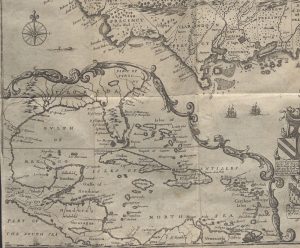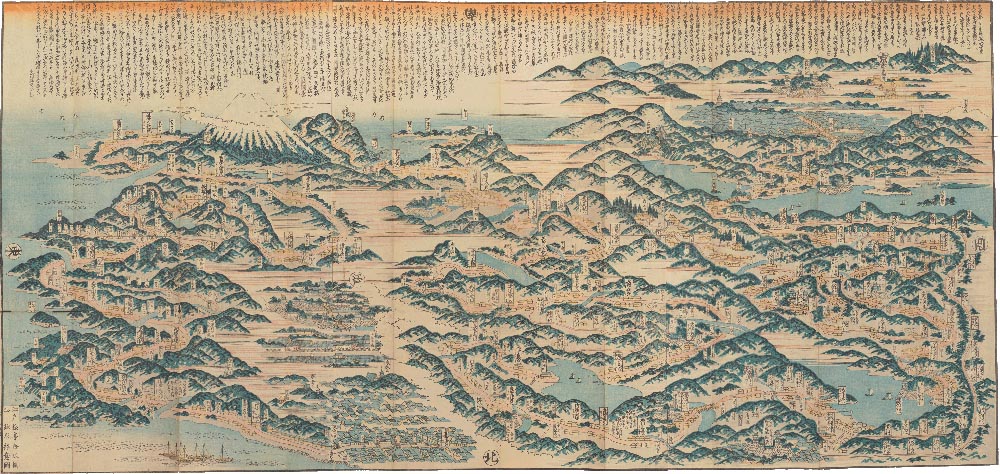Core Program
-
- 2024–5 Early Global Caribbean
- 2023–4 Open Edo
- Browse list of Core Programs, 1991–.
2024–25 | Early Global Caribbean
Organized by Carla Pestana (History, UCLA) and Gabriel de Avilez Rocha (Brown University)

The Caribbean has been a site of global interaction and dramatic change for centuries. Although consideration of the impact of the forces of globalization on the region often focuses on the eighteenth-and-nineteenth-centuries era of sugar and slaves, Caribbean people’s engagement with those forces long predates the period of the plantation complex. Yet a concerted reckoning with earlier global dimensions of Caribbean history, especially one that considers recent advances in scholarly understandings of Indigenous and early colonial histories of the region, has yet to be accomplished. This cycle of conferences and events will serve as an important catalyst for inter-disciplinary dialogue that will move Caribbean studies towards centering transformations in the region’s societies, cultures, ideas, and environments during a period that is conventionally assumed to be prefatory to the histories that followed in its wake.
Conference 1: Convergences
October 18–19, 2024
The Caribbean became global through successive aggregations of disparate peoples across a wide span of time. Long before the arrival of Europeans, the Caribbean Sea served as a bridge among the more than 700 islands that dot the area. For millennia, Indigenous people moved among islands and between them and the adjacent mainland, motived by settlement, trade, and conflict. The circulation of peoples accelerated with the advent of Europeans who seized lands, killed many residents, displaced others, and facilitated the transshipment into the region of scores of enslaved Africans. Black Diasporic individuals would themselves follow routes that introduced new cohesion and terrains of struggle to the region. This meeting will consider the historical constructions of Caribbean space, the waves of people who moved through it across different temporalities before 1700, and the results—both violent and otherwise—that followed these contacts.
Conference 2: Convictions
February 21–22, 2025
The diverse peoples who converged on the Caribbean before 1700 held a range of differing beliefs, ideas about the natural world, and understandings of social, political, and spiritual order. Considering how Indigenous, African, and European systems of thought and faith clashed, adapted, and transformed will be the focus of this second meeting. We invite participants to consider how culturally specific systems of knowledge were expressed and transformed under emergent rubrics of what would become known as religion, science, and law. We will likewise reflect on how these ideas animated the creation and maintenance of institutions of governance and knowledge production both in the Caribbean and extending beyond it. This conference grants an opportunity to weigh how the globalization of the early Caribbean marked historical changes in beliefs and ideas but also witnessed continuities that cut across the 1492 divide. In the process, a multitude of convictions about spiritual, natural, corporal, social and political order helped shape (and were reshaped by) encounters in the Basin.
Conference 3: Materialities
April 11–12, 2025
The tangible realities of daily life and the patterns of exchange in the Caribbean and the other Atlantic regions integrated into the Caribbean’s orbit enhance our understanding of the local dimensions of global processes that have long shaped the Caribbean Basin. This final conference will consider how the region’s early global histories may be tracked through their material manifestations in constructed and natural environments from a variety of different disciplinary perspectives. Focusing on the materials embedded and moving through Caribbean land- and waterscapes prompts lines of investigation about how historical interactions and social constructions of meaning were mediated across different historical moments. These interactions and constructions can be explored through physical artifacts, objects, and living organisms. We will deliberate on how both the environment itself and the material cultural productions of the people living in the Basin were profoundly and continuously influenced by the advent of different groups, the imposition of new agricultural regimes, and a host of other aspects of quotidian life that persisted, gained new forms, or disappeared. To what extent might the historical study of transformations in the circumstances of life in the Caribbean benefit from considering distributed agencies of different human and non-human actors across time? What do considerations of materiality in or beyond traditional archives contribute to a global understanding of Caribbean history?
2023–24 | Open Edo: Diverse, Ecological, and Global Perspectives on Japanese Art, 1603–1868
Organized by Kristopher W. Kersey (Art History, UCLA)

The art of Japan’s Edo period (1603–1868) presents a paradox. On the one hand, the nineteenth-century proliferation of ukiyo-e—polychrome woodblock prints of the “floating words” of theater and sex work—made the popular visual culture of this city a familiar component of modern art in the nineteenth and twentieth centuries. Yet the outsize fascination with ukiyo-e outside Japan has sorely obscured Edo’s far more diverse social, material, and artistic landscapes. In an effort to countervail the enduring stereotypes of early modern Japanese art, Open Edo will present a suite of conferences addressing three interlinked themes: the representation and agency of marginalized groups, the ecological horizons of artistic production, and the ongoing need to counter the myth that Japan in early modernity was somehow disconnected from the rest of the world. Throughout the year-long series, the focus will be both historical and historiographical inasmuch as Open Edo asks how Japanese art history might challenge the discourse of early modernity writ large. Each conference will incorporate a site visit to an Edo-period archival resources in Southern California. At the conclusion of the year, selected papers will be assembled for publication in the UCLA Clark Memorial Library Series.
Conference 1
Global Edo: Edo in the World and the World in Edo
October 13, 2023
The subject of this initial conference is the longstanding myth that Japan was hermetically sealed from the rest of the world from the 1630s to 1853. While international travel and trade were indeed forbidden, Japan remained networked with the those beyond its shores through trade with the continent, the Dutch, the Ainu, and the Ryūkyūs. During this period, fantasies of Japan proliferated abroad, just as fantasies of the outside world proliferated in Japan. Yet the restrictions on international exchange did not mean that Japan was somehow isolated from modernity. In fact, the metropolis of Edo actually exhibited many of the aspects that would later come to be seen as “modern” by the European definition of the term. Put more forcefully, early modernity seemed to thrive in a society that eschewed the Eurocentric model of “globalization.” Likewise, one should not conflate the Edo metropolis with the eponymous era, for an exciting feature of early modern Japan is the existence of multiple metropolitan centers, from Osaka and Kyoto to Nagasaki. As such, this initial conference seeks papers that will reframe the Edo period in more porous, global, networked, and dynamic terms.
Conference 2
Eco Edo: Ecological Perspectives on Early Modern Japanese Art
February 2, 2024
The highly urbanized nature of the Edo period—with its three metropolises of Osaka, Kyoto, and Edo—resulted in massive changes to the natural and built environments. The bustling economies of these cities fueled wide-reaching networks of production, trade, and environmental exploitation. The concept of nature itself, as well as the iconography of natural history, were likewise in flux. Accordingly, this conference seeks papers that will contribute to the emergent discourse of ecological art history by directing attention to the material and ecological horizons of early modern Japanese art. What were the aesthetics of environmental exploitation? How were industry and labor depicted? What were the religious perspectives on ecological manipulation? How were materiality and ecology themselves conceived? Where is the intersection of ecological ethics and artistic production?
Conference 3
Edo Outsiders: Ainu and Ryūkyūan Art
April 19, 2024
To this day, many mistake Japan for a culturally homogenous society, yet this nationalistic myth is far from the truth. In an effort to underscore the diversity of early modern Japan, this conference will direct attention to two groups who are often marginalized if not absent in narratives of early modern Japanese art. To the south are the Ryūkyūans, whose Kingdom of Ryūkyū was reduced in the Edo period to a vassal state. To the north are the Ainu, an indigenous society progressively dispossessed of its lands throughout Japanese history. Recent anniversaries—the 150th anniversary of settler colonialism in Hokkaidō and the fiftieth anniversary of the reversion of the Ryūkyūs from the USA to Japan—have brought renewed critical attention to the art of these two marginalized groups. While much scholarship on Ryūkyūan and Ainu art has focused on modernity, this conference seeks to shift the focus deeper in the archive, to the seventeenth to eighteenth centuries.

